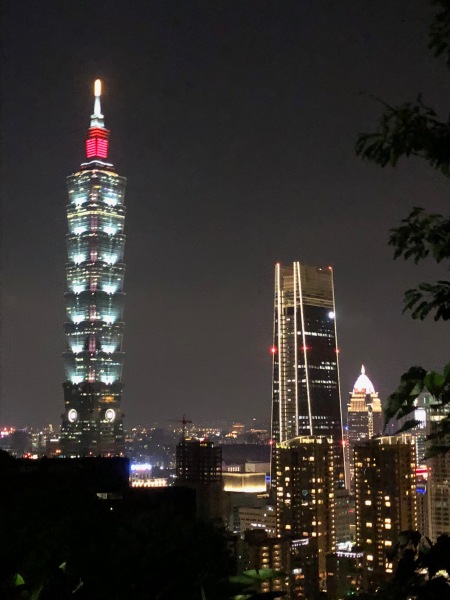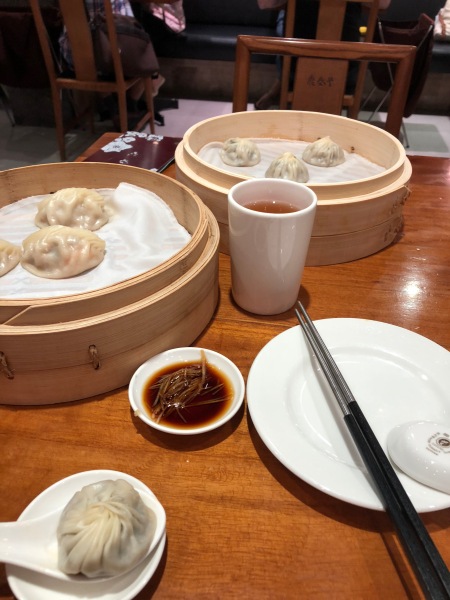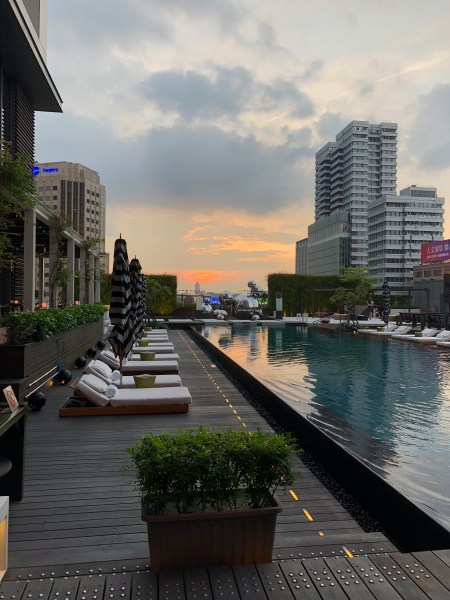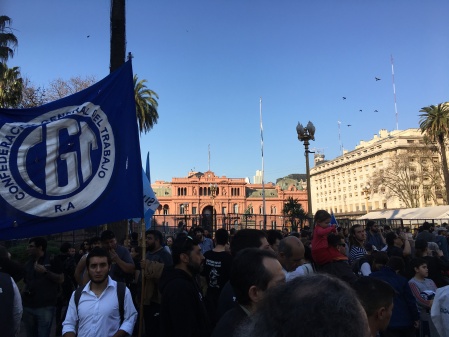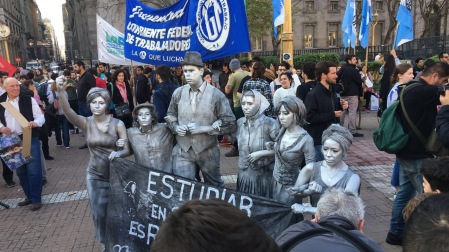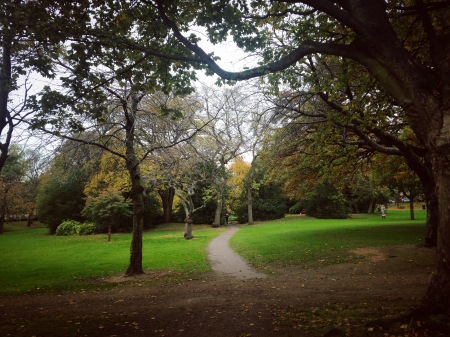Finally got around to a trip to Malaysia. I was a bit worried that it wouldn’t happen – all but 1 of my flat mates had been before, and the rest of my friends in Singapore were already busy reviewing for finals at SMU, which apparently is a bit of a colossal affair. My roommate Loic and I sat down one day and found a three-day period that we were both free of obligations, though, and decided to take a rather spontaneous trip to Kuala Lumpur, the country’s capital. In hindsight, given that I have four finals in a five days as opposed to the usual two week spread, it probably wasn’t a great time to go. But I wasn’t about to go back home after spending a semester in Singapore without a Malaysian immigration stamp on my passport.

A view from the bottom of the Petronas Towers. Inside are a series of malls full of luxury brands, like fifth avenue or orchard road compressed inside a city block.
The trip was absurdly cheap. I spent just under $120 or 3 days without really worrying too much about my budget, either. Roundtrip bus tickets cost about $30, two nights at a nice hostel were another $30, and the remaining $60 afforded me the opportunity to try anything I wanted from the famous Jalan Alor Street Food Night Market, a 90-minute massage, uber/grab transportation, and a few drinks at the local bar.

A view of Kuala Lumpur from the top of the KL Tower. It’s no New York, but it’s impressive that you can still see tall buildings in what seems to be miles away from the city center.
The hostel was probably the price that shocked me the most, as I expected something much cheaper. My classmates who had taken trips to other Southeast Asian counties like Thailand, Vietnam, or Cambodia, found similar quality or better lodging for around $5-10 a night, whereas even the luxury villa we booked on our earlier trip to Bali cost about $50 for 4 nights for much more extravagant lodging. But it was ultimately worth it – the hostel was right in the middle of the food street, and was at most a half hour cab ride away from the sights we wanted to see.

One of the many food stalls in the Jalan Alor Food Street. Like in Beijing and Xian food streets, nothing beats the lamb skewers in both taste and value.
When Loic and I found ourselves complaining about the price of the hostel as we sat outside the hostel eating lamb skewers and drinking sugar cane juice, we stopped for a moment and laughed at the absurdity of it. Back home, $15 a night for housing, especially of this quality, was nothing. We felt like living in Asia had given us a different conception of cheap and money. It was a realization that my classmates from the first semester and I had, too, towards the end of our stay in China. It’s probably one of the things I appreciate the most from spending so much time abroad – you get a better appreciation of money. If people can live off of x amount, it’s harder to justify spending at the rate you do when you’re back home in the U.S. on luxurious things.
There were five big places that we experienced – the Petronas Towers, the KL Tower, the Batu Caves, and the Sultan Abdul Samad Building, and of course the Alor food street. If TripAdvisor and my flatmates’ advice were to be heeded, these were the must see spots in Kuala Lumpur.

The outside of the Batu Caves. There are about 250 steps to get to the caves, with perhaps just as many wild monkeys to greet you on the way up.
The towers were absolutely gorgeous, though to be honest it felt like they didn’t fit in their surroundings. What I liked about Kuala Lumpur was that that there was a very nice and not too stark contrast between the old and the new. Like Manila, there were many worn down and dirty buildings, and interspersed among them were newer, cleaner, taller buildings that served a variety of purposes, from government buildings to corporate headquarters to residential areas. But they were never TOO clean, TOO new, TOO tall, so as to be strange – it just seemed like a city that, like many others, was growing up. Like Singapore, there was a lot of greenery in the metropolis that helped smooth out the edges of old and new, too. Parks flowed seamlessly into untamed jungle, and this somehow made the abandoned shacks or construction sites next to bank buildings seem natural, too.

We were wondering where the lights came from as the inside of the cave was well lit, and we were treated to this view after about a minute or two of walking inside.
But the Petronas Towers were just… too different. It wasn’t just the fact that the Towers (and the 30m shorter KL towers) were over 100m taller than the next tallest buildings, though that definitely played a big role. There was something about how the towers looked that made it seem distinctly not-so Kuala Lumpur. Its metallic silver color and the layered outside texture gives it an almost violent feeling that makes it seem like a ripple in the much more relaxed and low-key set-up of the rest of the city. Maybe that’s why it’s such a famous building – not just for its size, but for the emotions you get when you look up from the earth in Kuala Lumpur and see something so alien.
The KL Towers, unfortunately, didn’t impress quite as much. It wasn’t so much the fault of the building – it, too, is quite tall, standing at 420 meters, though aesthetically it’s quite plain outside of the sphere-like structure at the top of the tower. It was the fault of the view, really. The sky and observation decks of the the tower, which are its main attractions, offered a great vantage point to view the rest of the city. But that was just the problem – there really wasn’t that much to see. Besides the Petronas Towers, most of Kuala Lumpur’s skyline is quite unimpressive, though it was surprising to see just how far out the city stretched. The view, though, did cement the contrast that I talked about previously – sometimes you would see two buildings next to each other that looked identical, only one was a cleaner, newer, and taller version of the other.
The Batu Caves were the the highlight of the trip, for sure. The site’s main attraction is the series of cave and Hindu temples inside. When my flatmates who had been before talked about it, it sounded like they weren’t too impressed: they said they didn’t really understand the religious significance or what was so impressive about a bunch of caves. To be honest, I don’t either – it seemed just like any other Hindu temple that I’d seen. But it’s one of those things where once you walk up the stairs, past all the wild monkeys eating fruit and drinking from bottles left behind, and into the damp, naturally light caves and see the monuments and altars scattered around, as if they were just left behind by their creators, there’s a really strange and almost magical feeling you get inside you. This place just seemed so remote, so far away from society, so serene – and especially in contrast with the hustle and bustle of Kuala Lumpur and Singapore, the moment of quiet is special.

The Sultan Abdul Samad Building. Currently under renovation, so we couldn’t go inside – but the outside served for a good enough background photo.
The Sultan Abdul Samad building was just a pretty thing to look at, to be honest. We didn’t spend much time there at all, but my flatmate and I did end up relaxing in the green just across from it. It had a very country club feel to it – there were a few fancy restaurants and a beautiful white marble forum right next to it – but somehow, there were very few people in the green itself, even though we were there during what I would imagine to be peak hours, just after people would start getting out of school or work and just before it got dark.
A really interesting place. I don’t think Kuala Lumpur is a must-visit by any means, but I’m really happy I made the trip out .





 Posted by bryanintaipei
Posted by bryanintaipei 